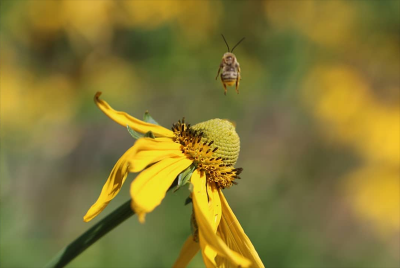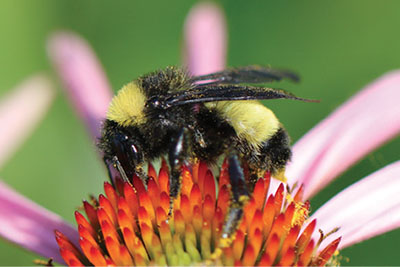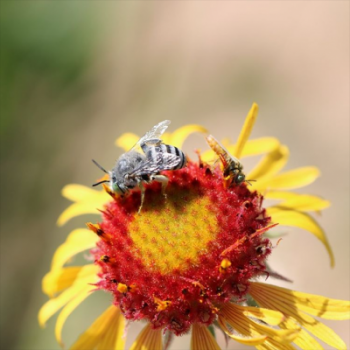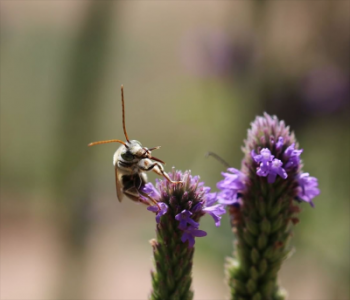March 20, 2021
Landscaping for Pollinator Diversity
Guest Authors: Dr. Amanda Skidmore, NMSU Extension Integrated Pest Management (IPM) Specialist and Dr. Ge Zhang, IPM Postdoctoral Researcher
-- Q&A from a recent Ready, Set, GROW! Gardening Webinar --
Question: Are all bees beneficial?
Answer: For the most part, yes. Wild bees and honey bees need pollen and nectar to survive and establish their nests. Some bees can become pests when they build nests in areas where humans (or animals) live and play, but even those bees offer benefits as pollinators. Many bees look for open cavities or cracks in trees and walls where they can build their nests. To prevent bees from being pests in structures, patch holes or use screening.
Question: Where is the best place to hang artificial bee houses?
Answer: Bee houses can be a great way to observe pollinators in your yard (and can be especially fun for kids). If you want to install one, place it in an area where it will not be in direct sunlight all day (under a tree or off the shadier side of a porch) and near flowers and habitat resources. Note: You must clean your bee houses every spring (after old bees emerge and before new bees are looking to nest). The old, previously used houses can be a source of disease spread and kill more pollinators than they help. One strategy is to use rolled up paper linings in each hole. They can easily be removed and replaced on an annual basis.

Question: Do all insects see pixelated images?
Answer: Insects have compound eyes that are made up of individual lenses called ommatidium. The more ommatidia an insect has, the clearer it can see. For example, flies, praying mantises, and dragonflies often have large eyes with lots of ommatidia because they rely on vision to navigate the world around them. Other insects, like many beetles, ants, and aphids, have smaller eyes and use other senses to navigate.
Question: How did scientists discover how insects see?
Answer: All the info you could ever want and more in this Insect Vision (YouTube video).
Question: Can bees be kept in higher elevations/colder climates (e.g., Los Alamos County)?
Answer: Honey bees adapt to a wide range of climates and elevations, from the hot arid desert (like Saudi Araba) and humid rainforest (like the Amazon forest) to arctic zones (like Alaska) and from lowland to highland. These management tips can help keep healthy bee colonies in colder climates: Buying bees from a local beekeeper who has kept local bees for years could give you a higher chance of getting cold-resistant stock. During long, cold winters, both wrapping hives with a cover and placing hives in a sunny, sheltered spot to block strong winds can help bees survive better. Before winter, make sure bee hives have abundant honey. If honey stores are low, supplement with liquid and solid sugar.

Question: Do honey bees compete with wild bees? Will wild bees be pushed out of a yard or neighborhood by honey bees kept in a backyard?
Answer: Honey bees can compete with wild bees because honey bees may overlap with wild bees in flowers where they collect nectar or pollen for food. However, honey bees are not the direct cause of wild bee decline. Honey bees are generalist foragers, but they do not necessarily use all floral species in a landscape. Honey bees can also be actively collecting nectar at different times of the day compared to wild bees. For example, some large-bodied wild bees (bumble bees and carpenter bees) forage in the early morning with cooler temperatures when honey bees are inactive. Landscaping with a diversity of flower shapes and colors can attract different bee species and reduce competition between honey bees and wild bees, thus supporting both beekeeping practice and wild bee populations.
Question: How much yard space do you need to have a healthy beehive?
Answer: The space to support a healthy beehive is scenario-dependent. Because honey bees can fly up to about six miles to collect nectar and pollen, the carrying capacity of a given space depends on the abundance of floral resources grown in that yard and the larger surrounding area. Plentiful floral resources within a short distance to beehives can enhance honey bee foraging efficiency by saving energy during flight. Considering the dry climate in New Mexico and relatively low flower density in the desert landscape, much more property is recommended to support a healthy beehive. In a flower-rich habitat and landscape, multiple colonies can be supported per acre of land.

Question: Are there preferred ways to provide clean water for bees? How clean is clean? Will a birdbath be too dirty for the bees?
Answer: Tap water is clean enough for honey bees to drink. Do not feed bees with water after washing dishes or hands with detergent. When filling a container with water, adding some stones or twigs will help them access the water and avoid drowning in the container. A birdbath is OK for honey bee drinking. Note: If you use a hand sprayer or wash something (car, pressure washer) that results in pooling or standing water, pollinators and other arthropods might be attracted to it. Residual chemicals in these solutions can cause toxicity. It is recommended to rinse an area thoroughly and always follow disposal instructions on labeled products.
Question: Is overhead spray irrigation better than drip irrigation for a bee/butterfly garden?
Answer: Theoretically, spray irrigation can interrupt flower-visiting activities of these pollinators in the garden. Droplets in the air can make flight harder and wash out or muddy the pollen, making pollen collection harder. Pollinators will turn to an undisturbed garden from a sprayed garden to collect their food. In contrast, drip irrigation will have minimal interruption on foraging activities of pollinators. One solution is to only use sprinklers at times when bees are not actively foraging (evening, predawn).
Question: Do we have leafcutter bees in New Mexico?
Answer: Leafcutter bees are living in New Mexico. Most members of this family nest in holes in dead wood or hollow twigs. They get their common name because they use chewed leaves or mud to construct and seal their nests. Some of these species cut neat, almost circular holes from the leaf edges on roses and other landscape plants. Generally, this damage is not sufficient to affect the growth of the plant.
Related NMSU Extension Publications:
- Pocket Guide to the Native Bees of New Mexico
- Circular 655: Integrated Pest Management (IPM) for Home Gardeners
- Guide H-172: Backyard Beneficial Insects in New Mexico
Find a recording of the presentation that inspired all of these questions, “Designing Landscapes for Diversity,” at Desert Blooms. While you’re there, register for one (or all) of our upcoming Ready, Set, GROW! Gardening Webinars.

Marisa Y. Thompson, PhD, is the Extension Horticulture Specialist, in the Department of Extension Plant Sciences at the New Mexico State University Los Lunas Agricultural Science Center, email: desertblooms@nmsu.edu, office: 505-865-7340, ext. 113.
Links:
For more gardening information, visit the NMSU Extension Horticulture page at Desert Blooms and the NMSU Horticulture Publications page.
Send gardening questions to Southwest Yard and Garden - Attn: Dr. Marisa Thompson at desertblooms@nmsu.edu, or at the Desert Blooms Facebook page.
Please copy your County Extension Agent and indicate your county of residence when you submit your question!